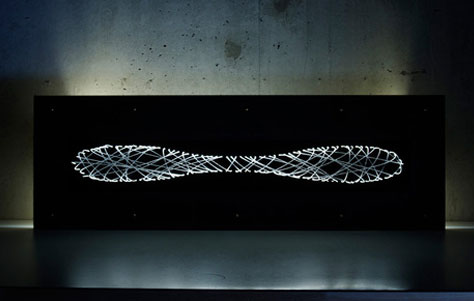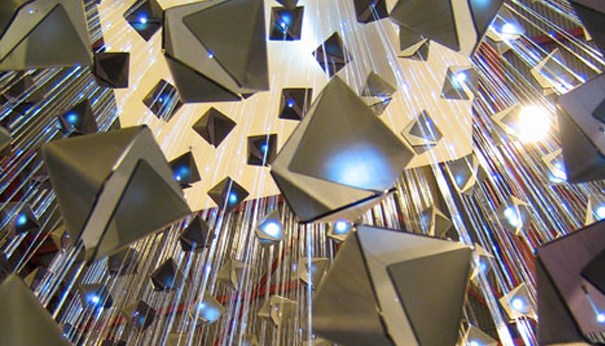Studio 1:1’s Boogie Chandelier Frightens Away the Same Old, Same Old
Luke Matheny, the crazy-haired recipient of the Best Short Film award at this year’s Oscars, reported having surprised Tom Hanks by telling him how much he admired Joe Versus the Volcano, a kitschy comic affair that doesn’t typically top the list of Hanks’ artistic achievements. I’ve got a soft spot for that film too, as it traces the arc of a work-a-day drone from hum-drum despondence to luminous fulfillment. Indeed, the film is rife with light imagery, beginning with the “suck-suck-suck” and hum of the deadening workplace fluorescents, and ending with the literal and figurative enlightenment of a maritime moon as big as Texas. That’s a long way of articulating my admiration for Studio 1:1’s Boogie Light, a creative and compelling fiber optic loop of a chandelier, begun upon the skeletal artifact of “one of those ugly fluorescent ceiling-hung lights one can only put in the basement.”
Boogie Chandelier. Designed by Studio 1:1.
The Illusion of Doubling Creates a Synchronous Glow
Thankfully, the designers of Boogie hadn’t permanently consigned that ostensible scrap of junk to the refuse bin, for “this fixture uses one just like that… but what a difference a bunch of light transmitting cables and reflective materials can make.” A mild understatement, I’d say, for the Boogie Light doesn’t just bring hapless Joe’s life-sapping fixture back to life, it re-appropriates it as the command center for an aesthetic tour de force that’s leagues away from the drab bulb and cheap tin of its former incarnation. Boogie may get its power source and its structural integrity from the defunct fluorescent, but its aesthetic allure emerges from the illuminatory imbibements and curvaceous potentiality of fiber optics.


That and a deceptive flat expanse of “reflective surface” deed the piece a mysterious phosphorescence, an ethereal glow whose pale double (the reflection) gives a satisfying symmetry to the whole. The piece thus creates a new aesthetic that Mies certainly would have admired, as Boogie’s function is its form—thus asserting a ghostly aspect that, while it’s not without precedent (see Mies’ Nightmare, the Atlantis Chandelier, and the Mr. Hyde Sofa), is yet unseen in this particular incarnation, with this particular palette of materials: “Using fiber optics gives endless opportunities for the tangible sculpting of light and engages our sense of touch in experiencing it.”
Via MocoLoco.


Leave a Reply